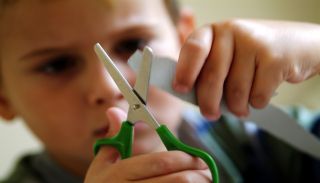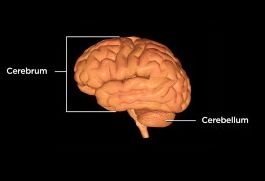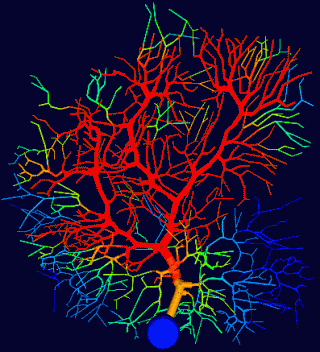Autism
Research Links Autism Severity With Motor Skill Deficiencies
The cerebellum may be linked to motor skill deficiencies and autism severity.
Posted April 30, 2014

A new study from Oregon State University is believed to be the first to show a relationship between the severity of autism spectrum disorder (ASD) and motor skill deficiencies in very young children. The study titled “Motor Skills and Calibrated Autism Severity in Young Children With Autism Spectrum Disorder” was published in the April 2014 issue of the journal Adapted Physical Activity Quarterly.
Researcher, Megan MacDonald—an assistant professor in OSU's College of Public Health and Human Sciences—believes these findings suggest that the development of fine and gross motor skills should be included in treatment plans for young children with autism. According to MacDonald, the earlier motor skill deficits are identified the more time there is to help children catch up to their peers in regards to motor skill development.
MacDonald is an expert on movement skills in children with autism spectrum disorders. Her research focuses on how improving motor skills and being physically active can improve the overall well-being of children with, and without, disabilities. The current thrust of her research is to identify the most effective ways to improve motor skills for children with autism.

In her most recent study, MacDonald found that very young children with autism were about six months behind in gross motor skills, such as running and jumping. MacDonald also found that the children with autism were nearly a year behind their typical peers in fine motor skills, such as holding a spoon or grasping a small toy. Interestingly, the lag in motor skills development among the children with autism was not linked to intellectual ability.
MacDonald points out that these motor skill gaps are of significant concern because twelve months between 1 and 3-years-old represents almost one-third of a young person's life. The research was based on a study of the development and motor skills of 159 children ages 12 months to 33 months old, including 110 children with an autism diagnosis.
I wrote about a previous study by Megan MacDonald in a September 2013 Psychology Today blog post “How Is the Cerebellum Linked to Autism Spectrum Disorders?” In that study, MacDonald found that in a group of toddlers and preschoolers with autism that the children with better motor skills were also more adept at socializing and interactive communication.
What is the Link Between the Cerebellum, Motor Skills, and ASD?

My father was a neuroscientist and neurosurgeon who was obsessed with identifying how cerebellar (of or pertaining to the cerebellum) dysfunctions played out in neurological disorders such as ASD. He passed this fascination with the cerebellum on to me. I have had my antennae up for research on the cerebellum for well over a decade since I first began writing The Athlete's Way (St. Martin's Press).
In 2009, the first neuroimaging study to examine motor execution in children with autism uncovered revolutionary insights into the neurological basis of autism by linking motor skill deficiencies to brain connectivity between various regions. The study titled “First Neuroimaging Study Examining Motor Execution In Children With Autism Reveals New Insights,” was published online in the journal April 2009 Brain Advanced Access.
In the study, researchers compared the brain activity of children with high functioning autism and their typically developing peers while performing a simple motor task of tapping their fingers in sequence. Tapping fingers in a sequence is commonly believed to be linked to cerebellar function.
Children with autism relied more heavily on a region of the brain responsible for conscious, effortful movement, while their typically developing peers utilized a region of the brain important for automating motor tasks. Children with autism also showed less connectivity between different regions of the brain involved in coordinating and executing movements.

Purkinje Cell in Technicolor
In another study from March 2013, a research team at Boston Children’s Hospital lead by Mustafa Sahin, associate professor of neurology, honed in on the gene Tsc2 in Purkinje cells and found that loss of Tsc2 in Purkinje cells lead to autistic-like behavioral deficits. The researchers believe their findings provide compelling evidence that Purkinje cell loss in the cerebellum and/or dysfunction may be an important link between ASD.
Another study published in April 2013 by researchers from the School of Child Development at Osaka University Graduate School of Medicine found that underconnectivity between the cerebellum and other brain regions contributes to the features of ASD behavioral deficits.
In May 2013, researchers from the Brain and Mind Research Institute at Weill Cornell Medical College found that defects in the Purkinje cells of the cerebellum are linked to ASD deficits. Their study titled “Defining the Role of Cerebellar Purkinje Cells in Autism Spectrum Disorders" was published in the journal Cerebellum.
Conclusion: Teaching Motor Skills Might Help Reduce ASD Severity
Megan MacDonald hopes that her new research at Oregon State University will help build awareness about the importance of motor skill development in treatment plans for ASD. Unfortunately, most therapies for autism tend to neglect the importance of motor skill development.
MacDonald believes that incorporating fine and gross motor skill development into early interventions could provide a boost and create an upward spiral. She also recommends that parents consider specific adaptive physical education programs, which are designed around a child's abilities and needs. In future studies MacDonald is going to compare different types of motor skill interventions to isolate which treatments are most effective.
Ultimately, MacDonald hopes this new research drives home the importance of motor skill development and the need to include adapted physical education and physical and occupational therapy in treatment plans for autism spectrum disorders.
If you’d like to read more on this topic, check out my Psychology Today blog posts:
- “How Is the Cerebellum Linked to Autism Spectrum Disorders?”
- "Autism Genes Can Disrupt Connectivity Between Brain Regions"
- “Physical Activity Empowers Kids to Achieve Personal Bests"
- "Neuroscientists Discover How Practice Makes Perfect"
- "Hand Gesturing Engages All Four Brain Hemispheres"
- "Can Oxytocin Improve Brain Function in Children With Autism?"
- “One More Reason to Unplug Your Television”
- "Can Physical Activities Improve Fluid Intelligence?
- “Hand-Eye Coordination Improves Cognitive and Social Skills
- "Better Motor Skills Linked to Higher Academic Scores"
Follow me on Twitter @ckbergland for updates on The Athlete’s Way blog posts.




